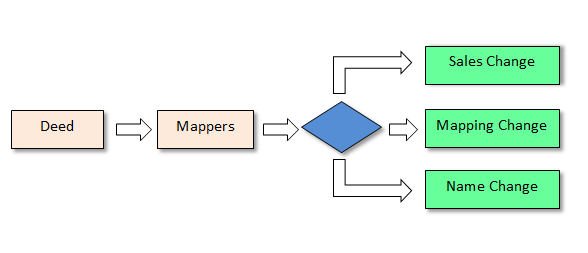![]()
Deed Processing

Each department has specific roles when it comes to processing deeds. Mappers are in charge of identifying (based on legal description), deleting, modifying, and creating parcels. Mappers process the deeds that come in from the Deed Register or from assessors. Deeds processed by the mappers will drive the legal changes and modifications. Once the mapper reads the deed, he or she will determine what actions the deed requires: sales owner, legal change, and/or ownership change. Since mappers handle legal changes, the mapper may delete parcels, create new parcels, or modify parcels. For instance, if a parcel is being split in two, then the legal description must be altered to reflect that change.
Defining a Deed
A deed is a legal instrument that conveys changes made to real property. There are three types of deed driven changes:
o Ownership Change: The property owner (grantor) grants a parcel to another person or persons (grantee). This is often, but not always, done through a sale.
o Legal Change: The parcel’s legal description is changed by creating, deleting, or modifying one or more parcel boundaries.
o Sales Change: When a sale occurs, a deed will contain information about the sale. This information includes the sale price and sales date and is used for appraisal analysis.
A single deed may convey multiple types of changes. To ensure accuracy, mappers must pay close attention to what changes are indicated on the deed and then properly translate that information to Capture.
There are various types of deeds that can be used to convey changes to property. Some of the most commonly used deed types are Warranty, Quitclaim, and Foreclosure Deeds. All deeds have certain information that is important to the mappers, assessors, and appraisers. There are various pieces of information that may appear on the deed and this information can be analyzed and entered to Capture.
Entering Deeds to Capture
Before a deed can be processed, it must be entered to Capture. There are two ways a deed can be entered, Manual Entry or by being imported from the Deed Register - this will happen by a nightly run job.
o Manual Deeds: If a deed is not imported by the Deed Register, a new deed can be manually entered by either a mapper or an assessor. (The ability to add a deed will vary by county). Since taxpayers are not required to record a deed with the Deed Register, deeds may be brought directly into the mapping/assessment office. Manually created deeds will allow mappers and assessors to begin processing deed driven changes.
o Imported Deeds: Each county has a probate office that is responsible for recording deeds. Capture CAMA allows deeds to be imported from the Deed Register. The Deed Register is a separate entity and is not a Capture customer. The Deed Register software must be specially configured to communicate with Capture.
Deed Dashboard
In Capture, the Deed Dashboard is used to process deed driven changes to parcels. Mappers, assessors, and appraisers can access the deed register to perform their assigned duties.
Parcel Actions
In many cases, deeds will require that changes be made to parcels. A deed may call for one or more of the following types of changes:
o Ownership Change
o Legal Change
o Sales Change
The mapping department is responsible for reading incoming deeds and determining which parcels will be affected.
Mappers will also determine what type of parcel action is initiated by the deed.
Ownership Change
A parcel can be transferred to a new owner by a sale, gift, or other means. The property owner is known as the grantor, and the person being granted ownership is known as the grantee. There may be multiple grantors or grantees on a deed.
When a parcel changes ownership, the following updates are made:
o Owner Name: The owner name is changed to that of the new owner.
o Address: The mailing address is updated, if necessary.
o Exemptions: Any exemptions on the parcel are removed. The new owner must reapply to receive exemptions.
o Property Class: The property class may be changed to Class II.
o Current Use: The assessor should check for and remove current use. The new owner must reapply to receive current use on the parcel.
Assessors are responsible for processing ownership changes and any of the other related updates.
![]()
Confidential | Copyright © 2001-2015 E-Ring, Inc.